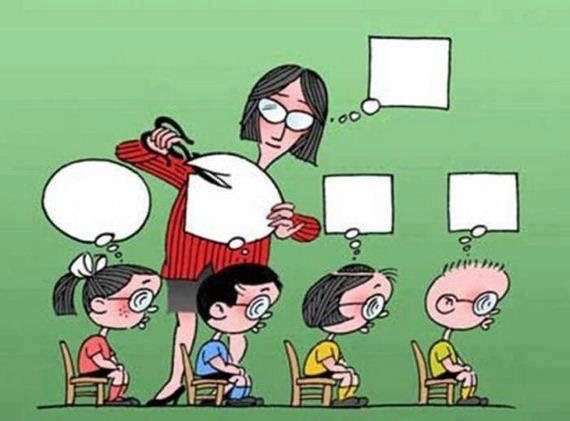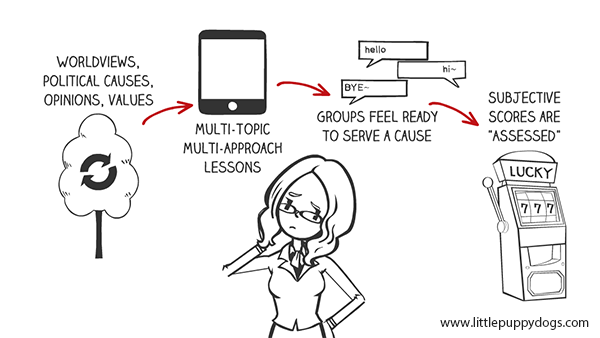Here are 10 reasons to avoid The Leader in Me program in your school. When a school adopts the program, it’s 7 habits are presented as absolutes and repeated endlessly. The habits are not universal truths.
1. The habits are presented as absolutes.
The habits should not be treated as absolutes, yet they are. Each habit may have a time and a place as a guideline but they are not absolute wisdom. If fact, often they are exactly the wrong advice.
Be Proactive (Habit 1) can be sound advice when the student is taught to think for himself and act on his own without the need for assistance. However, as a habit and in the classroom, this message is generally communicated as “obey”. Of course, obeying rules is a good thing to maintain order in a classroom or at home. But it is not a life-lesson absolute and should not be presented as such. There are times in life to obey and times to disobey. As they proceed in life, it’s not healthy for kids to always feel that obeying is the best option or even the first option. Kids need to know when it is proper to obey, such as in a classroom setting, and when it is proper to stand up and say “no, I do not agree and will not do that”. Perhaps in this example it would be proper to discuss this as a class rule, but certainly not an attribute of a good leader or an absolute in life.
Together is better (Habit 6) is not an absolute. Often one dedicated person with a vision accomplishes more in less time. History is full of brilliant individuals that accomplished the unbelievable by themselves.
Thinking Win-Win (Habit 4) is not an absolute. Standing up for yourself when you are right and someone else is wrong is the right thing to do. You don’t compromise with bullies or liars or thieves.
2. The habits are repeated, over, and over, and over.
The habits are everywhere at school, are pushed on parents and are encouraged in life outside of school. You will not be able to avoid them and your kids will be exposed to them non-stop. At our school the habits are reiterated from dawn to dusk and beyond the classroom, every day, all day. They are found in and among: morning announcements, posters, emails from teachers and faculty, phone calls from teachers and faculty, automated phone calls, teacher podiums and classroom walls, the cover of the yearbook, in the lessons, themes for fairs and fundraisers, faculty presentations and opening statements, parent training events, parent-teacher conferences and even suggested as inspiration over holidays.
3. The habits overstep the role of the school.
As a parent, I feel that values should be taught at home and any values taught at school should not depend on worldview. Values such as self-discipline, respect for others, hard work and integrity seem universal. And while the leader in me claims to promote such values the program also encourages peer dependence, group-think, emotion-based decisions and save-the-world goal setting. While some may find these latter values acceptable, many do not.
4. The habits are suitable for training workers, not entrepreneurs.
The habits do not promote innovation. They teach task execution. “Get it done”, “do it efficiently”, “meet the schedule”, “don’t squabble”, etc are all good traits but they set the bar very low and hide important attributes that kids will need to position themselves for a greater impact in life. People need to know how to think, to solve problems and to arrive at solutions that might not be fit a specific process. In other words, they will have to lead and forge new paths to the solution. To do so they will have to remove themselves from the tiny “task-based” box that the Leader in Me traps them in.
To succeed at a higher level, they will have to improvise, to focus, to create, to have original ideas, to gain knowledge, to put in the hard time, to succeed, to fail, to learn from mistakes, to compete, to win, to lose, to solve problems on their own, to take risks, to seek individual rewards, to be a rugged individual, to work late into the night, to dedicate years to an endeavor, to stand by your argument, to know facts, to communicate as a person and many other values. Many of these values are counter to the habit’s absolute language.
5. Many real-world habits of true leaders are missing.
The program is marketed as a “leadership” program, but it is not. Where in the habits do you see real-world leadership attributes like vision, or perseverance, or flexibility, or quick thinking, or rapid responses to changes, or creativity, or communication skills? They aren’t promoted with the habits and these are just a few examples of values that leaders need. Out-of-the-box thinking or critical thinking is not important to the program, instead they place all emphasis on compliance with rules, dependence on peers and adherence to a given process. That is not leadership at all. This sounds more like a follower to me. Remember, the program deals in absolutes and kids are taught that these habits define leadership.
6. The habits highlight the group over the individual.
When the individual is discussed in the habits it is always in the context of serving the school, saving the world, serving the community, or simply obeying rules. This encourages responsibility, order and discipline but it is not about the person, or the individual at all. The individual is told that they are important in the context of how they sacrifice themselves to accomplish other people’s priorities or society’s noble cause-of-the-day. The habits do not encourage people to consider: who am i as a person, what do I want to achieve in life, what skills I possess that might be unique, what strengths do I have, what personal goals do I want to set for myself, what knowledge do I seek, what am I interested in, etc. The individual is discussed in terms of responsibility to others, not himself or herself.
7. The habits dehumanize communications.
The program encourages correspondence between students, teachers, administrators and even parents to be based on catch phrases like, “synergize”, “sharpen the saw” and “everyone can win”. The program refers to this as a “common voice”. This limits the human element in communication and correspondence becomes robot-like as the buzzwords are integrated, often unnaturally into communications.
8. The program misdirects school emphasis.
Schools involved in leader in me promote the program over all else. Our school has replaced the honor roll with a “Go Getter” award based on a students ability to comply with and promote the 7 habits. Our school proudly points to wall art that states “Everyone can Win!” instead of “work hard” or “be your best”. The yearbook cover reminds the kids and parents that the habits are the most important part of education. The program encourages, and our school has adopted, subjective grading schemes (like Rubric’s) and group learning initiatives (like Engage! Learning Model). Fundraisers are executed to purchase more Leader in Me signs and posters to further force the kids attention on the habits. Compliance to the 7 habits is prioritized and awarded over academic excellence.
9. Your child may be used for marketing purposes.
Schools that adopt The Leader in Me may be required to provide video clips of children reciting the habits. The kids are coached to recite a habit and it’s influence on camera. If the child is not a fan of the habits, like mine, then words are provided for them. These video clips of your children are taken without your knowledge and can be used to promote the program without your explicit permission (you signed the release form for the yearbook, right?).
10. The habits will be used inappropriately and ineffectively for conflict resolution.
The habits are so prevalent that wisdom is lost in how to deal with individual students that are not behaving properly. The school will seek to force-fit a habit as a means of conflict resolution. Unfortunately, the habits are focused on groups, so individuals that need guidance are not singled out. Instead a group is asked to come up with a “win-win” or “synergize” solution instead of directly dealing with the child causing the problem in the first place.
Bonus. The program is expensive.
Schools pay $50,000 or so annually for the program. This money could be better spent elsewhere or not collected in the first place.


